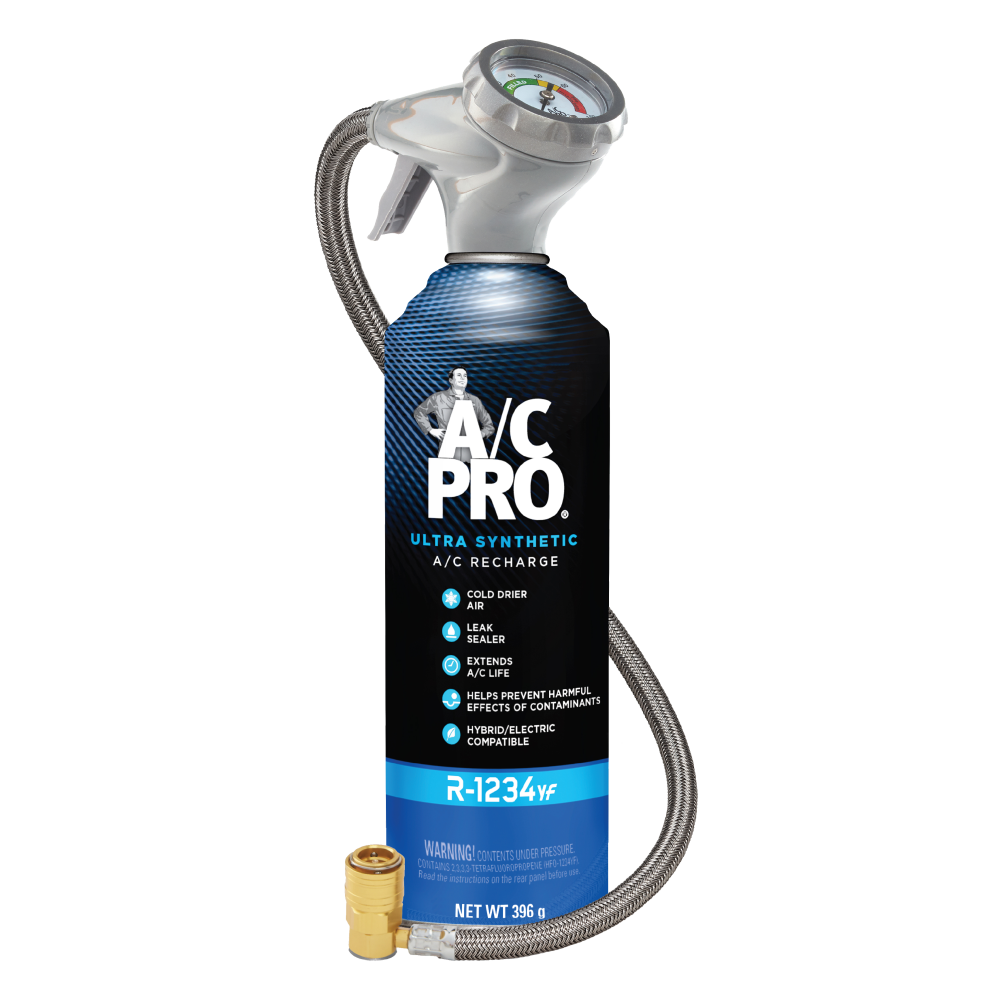ACPYF100-6 R-1234YF Recharge Kit, 14oz

Product features
- Easy-install
- Extends A/C Life
- Quick seal
- Works with hybrids and electric
Product Description
The A/C Pro® R-1234YF A/C recharge kit is designed to work with all vehicles with R-1234yf systems – including hybrids and electrics – with its specially designed formula and easy-install snap-lock coupler.
The advanced formula works quickly to seal common A/C leaks in rubber O-rings, gaskets, and hoses, while also providing anti-wear additives and preventing the effects of harmful contaminants such as oxygen. This R-1234yf recharge kit is easy and convenient to use with a universal gauge included that works with both self-sealing valves and piercing can tops.
- Provides colder, drier air with special additives designed to improve refrigerant performance within the A/C system.
- Excellent leak-sealing advanced formula works quickly to seal common A/C leaks in rubber O-rings, gaskets, and hoses.
- Extends A/C life by providing antiwear additives and preventing the effects of harmful contaminants such as oxygen.
- Works with all R-1234yf vehicles including hybrids and electrics
Usage Directions
-
- OPEN HOOD AND FIND THE LOW-PRESSURE A/C SERVICE PORT
With the engine off, open the hood and locate the low-pressure A/C service port (on the larger diameter tubing, between the compressor and evaporator). Remove the plastic cap from the port and save. NOTE: For best results charge under shade. Keep the car doors open while charging (front and back). - TURN ENGINE ON. TURN A/C ON HIGH
Start the car and turn on the A/C. Set the fan to highest setting and the temperature to its coldest setting. Make sure the recirculation mode is selected. - TURN THE GAUGE ON AND ATTACH THE QUICK CONNECT FITTING
Attach the quick connect fitting on the end of the recharge hose to the low-pressure service port identified earlier by pulling the connector ring back as the fitting is pushed on. Remove the clear plastic battery tab, and tum on the gauge by pressing the On/Off button.
Then, attach the quick-connect fitting on the end of the recharge hose to the low-pressure service port by pressing the back of the fitting on to the port.
NOTE: Our quick connect fitting will only attach on to the low-pressure port. - READ THE PRESSURE
Without pulling the trigger, look at the gauge to see the current pressure of the system. Match this pressure to PSI range/color on the indicator above the screen. Depending on the color, determine the next step according to grid below.
- REMOVE THE PLASTIC SPACER
Detach the gauge from your vehicle by pulling back on the connection ring to release the coupler. Unscrew and remove the plastic spacer between the trigger assembly and can. - CHARGE THE SYSTEM
Shake the can well, and screw can on to the gauge/trigger assembly. Reattach the quick-conect back on the low-side port. Make sure to always hold the can upright (12 o’clock position) before starting to charge.
Squeeze the trigger to charge the A/C system. While charging, shake the can up and down, alternating between an upright and sideways position. Every 15 seconds release the trigger, and check the PSI reading on the screen. TIP: It is typical for pressure to bounce around as the compressor is cycling. If that happens, read the lowest pressure. - STOP CHARGING WHEN THE PSI IS IN GREEN RANGE
BE CAREFUL NOT TO OVERCHARGE YOUR SYSTEM – DO NOT LET THE PSI READING MAKE IT INTO THE RED RANGE.
Once the PSI makes it anywhere between 26-50 PSI, check the vent temperature. If it is colder, then charging is complete. Do not try to get it to the highest part of the green zone or you risk overcharging. Remove the hose from the service port and replace the plastic cap when finished. Store any unused refrigerant in a cool, dry place
- OPEN HOOD AND FIND THE LOW-PRESSURE A/C SERVICE PORT
FAQs
-
The low side service valve is located in the line that runs from the compressor through the evaporator (firewall) and up to the condenser on the low pressure (suction) side of the system. R-134a recharge hoses will only fit on the low side service port on all R-134a vehicles and R-12 vehicles that have been converted to R-134a, and R-1234yf recharge hoses will only fit on the low side service port on R-1234yf vehicles. If you don’t know where your low side port is, you can try using our low side port finder.
The only fitting that the standard recharge equipment will fit is the low side service port.
-
The EPA requires that ANY replacement refrigerant MUST have unique fittings, charging devices and label. Therefore, the EPA states that “drop in” refrigerants are illegal. Furthermore, only R-134a has been tested and approved by the original equipment manufacturers.
-
No. Federal law prohibits topping off an R12 system with a different refrigerant. Your options are to locate some R12, however you must be certified to purchase, and add it with an R-12 recharge hose. Or you can convert the system using one of our R-134a retrofit kits that will allow you to now add 134a refrigerant to your automotive air conditioning system. You will have to make sure that you remove any residual R12 by having it evacuated prior to retrofitting your vehicle.
-
The answer here is twofold. It is possible that the system has a small leak, and now is low on refrigerant. This will allow the system to blow cold, but just not as cold as it used to. In this case, check the low-side pressure and verify if the system is low on refrigerant.
If it is low, add refrigerant or a refrigerant with a stop leak to the correct pressure. If your pressure is correct adding additional refrigerant will not make the system blow out colder air, but will in fact cause the system to become overcharged. This causes the system to work less efficiently and will result in warmer air blowing from the vents.
-
IDQ’s top off products contain the proper ratio of replacement oil.
-
We recommend using a pressure gauge to determine an accurate fill. A/C Pro’s color-coded gauges indicate whether you should continue filling (charging) or not.
-
No. Your car’s A/C refrigerant never goes bad. Nor do you “use up” the refrigerant that is in your system. If your vehicle’s A/C system pressure is low, your vehicle has a refrigerant leak and that leak will need to be repaired in order for your system to hold refrigerant.
If your vehicle is able to maintain a charge for a period of two weeks or longer, then it is possible to seal the leak with sealant such as Super Seal. If your system will not hold a charge for at least a two-week period, then it is advisable to seek professional assistance to find and repair the leak.
-
No. Not only is it harmful to the environment to vent refrigerant into the atmosphere, it is also illegal. Violation of this Federal Law may carry a fine of up to $25,000. If you need to recover refrigerant from your system, please seek the help of a qualified service technician.
-
- Turn the valve handle of the charging kit counterclockwise until the piercing stem is in the up position. This will prevent accidentally piercing the can. Screw the charging kit onto the can.
- Attach the quick connect fitting to the low side service port.
- Start engine and put A/C settings on maximum cool with the fan settings on high.
- Turn the valve handle clockwise until the piercing stem has punctured the can.
- Turn the valve counterclockwise until you feel the refrigerant leaving the can. See packaging for complete details. Always wear protective gloves and eyewear.
-
YES! This is one of the easiest jobs that you can do yourself on your vehicle. Please click through the following FAQs to learn more on using our products to recharge your car’s air conditioning.
Please feel free to call our technical support line for further help at 888-318-5454
-
In order to properly charge your automotive A/C system the ambient temperature should be above 65ºF. Anything below that does not allow the system to build up enough pressure for a proper reading on your A/C Pro pressure gauge. Because of this, adding refrigerant to your vehicle is not recommended when the ambient temperature is under 65ºF.
-
R-134a refrigerant and the additives that accompany our products do no expire or “go bad”. You can purchase an older generation can with confidence that its contents are just as capable as a newly packaged product.





